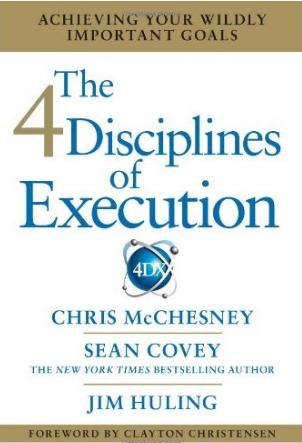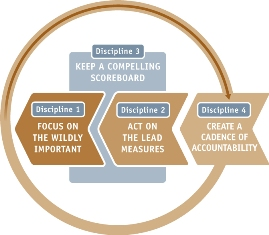26 Jun 2013
Holiday Time
We are on our way to Ontario for holidays. A family reunion, Canada Day on parliament hill, a few days in Montreal. Gonna be fun!
26 Jun 2013
We are on our way to Ontario for holidays. A family reunion, Canada Day on parliament hill, a few days in Montreal. Gonna be fun!
02 Apr 2013
Posted by Dave under Book Review,Dave's Thoughts
 The 4 Disciplines of Execution: Achieving Your Wildly Important Goals
The 4 Disciplines of Execution: Achieving Your Wildly Important Goals
by Chris McChesney, Sean Covey, Jim Huling; 2012; Free Press (ISBN: 978-1-4516-2705-3)
The 4 Disciplines of Execution, or “4DX” as the authors abbreviate the title, comes across as a pure business-oriented “pull your self up by the bootstraps and prosper” self-help book. The entire dust jacket, as well as the first 10 pages and the forward are filled with self-congratulatory bumpf that is stereotypical of the genre. Not a particularly compelling start…
So, what was I doing reading about the “next big thing” from the FranklinCovey Group? The 4DX concept, and the book, had been specifically mentioned by the director of the group that I am working for at TransCanada during a quarterly departmental update meeting. The 4DX principles were being used to set strategic and tactical direction for the group. Well, clearly, if my boss’s boss is interested in something, then so am I!
Once I got into the meat of the book, I found that my initial skeptical concerns were being addressed by a thoughtfully developed set of business practices that the author calls the four disciplines; these are:
The essence of the 4DX methodology is to select one extremely important goal out of numerous potential initiatives and objectives, which may be important in their own right but are not the most important. This focus is critical as it compels you to rise above the whirlwind of day-to-day business and be clear about what really matters. The focus is then quantified by stating it as a “get from A to B by this deadline”.
So far, not much new. The second and third disciplines are where the game changes into something a little different. The discipline 1 goal is stated as a measurable idea, “from A to B by date”, just like any other business book might advise. This is a measure that can only be reviewed – it lags the actual activities that cause the movement from A to B. By the time you get the report or scorecard it is too late to influence what you did last week or last month. Discipline 2 changes the emphasis towards actions that act as leverage on the goal by looking for another kind of measure – a leading measure. Leading measures are predictive and influence-able indicators of behaviours that support the goal. Discipline 3 then makes both the goal and the leading measures relevant by presenting the progress as a real-time scoreboard that shows clearly whether the team is winning or losing the game of reaching the goal.
It’s like a pick-up game of street hockey – the entire experience changes when scorekeeping starts and changes most significantly when the players themselves are the scorekeepers. The first three disciplines set up the game (focus on winning), provide leading indicators for behaviours related to achieving the win (how many shots on goal each shift?) and provide feedback on progress towards winning (what’s the score right now?).
 All well and good, but if these ideas set up the game, it’s the last one that puts the team in the game. Discipline 4 creates accountability for the independent actions of team members to move the game along. It is the communication that allows individuals to commit to action and follow-up. It is a cadence of checking in and checking up that moves the leading measures and gets results – despite the whirlwind.
All well and good, but if these ideas set up the game, it’s the last one that puts the team in the game. Discipline 4 creates accountability for the independent actions of team members to move the game along. It is the communication that allows individuals to commit to action and follow-up. It is a cadence of checking in and checking up that moves the leading measures and gets results – despite the whirlwind.
The inevitable question is then, “How do I actually do that?” The theory sounds good, but putting it into practice? This is where the authors have made an admirable attempt to get real. Using an interesting combination of text and web content accessed by QR codes in side notes, the authors have attempted to make the book a multi-media experience with short video clips of interviews with people who have put the 4DX ideas into practice. It works, sort of. The process of browsing to the website and watching a video clip takes a bit of time and disrupts the flow of the book. (Disclaimer: I actively despise the distracting habit many authors/publishers have of littering a book with large font excerpts from the text randomly interspersed in the prose.) Worse though, the second QR code I scanned didn’t take me to the extra content directly; instead it went to a sign-in page that wanted my name and email address before I could get to the content. Needless to say FranklinCovey simply gathered bogus information for their spam-victim database.
Bottom line on this book? I felt it was a good, concise take on a measurement based accountability system that should get results. Focusing on one important objective and reaching for it through smart use of leading measures and agile-style accountability makes sense and should be scalable to any sized team or organization. The how-to information is down-to-earth and accessible as well. This technique appears to be useable not only in business but in any other area of life where the chaos of the whirlwind might otherwise blow away the best of intentions to win the game.
25 Mar 2013
Posted by Dave under Dave's Thoughts,Mr. FixIt
It was a busy weekend. After celebrating my brother Scott’s birthday on Friday, he asked if I’d give him a hand sorting out his new laptop and getting a desk/work area in his new apartment. So on Saturday afternoon I headed over and we worked our way through the “to do” list. On the IT side, we configured his laptop, installed some software and set up some network attached storage for all his photos and media.
That was the easy part. His apartment is fairly small and there is an awkward little passage way into the kitchen that is currently set up as an open closet. There is no door and it just seems impractical for any real storage. At the same time, there is nowhere, other than the dining table, that is handy for a place to work. So we decided that it would be an ideal place to put a little desk to make a small office space. Only problem was that there was no power into the area.
That was fairly easily solved. A counter plug in the kitchen is located on the other side of the wall – it didn’t take too much effort to pop a hole in the drywall on the closet side and wire in a couple of outlets by extending the kitchen circuit. By the time we were done, it looked like it had always been that way.
Next was the desk surface – we used a quarter-sheet of 7/8ths white melamine faced MDF and cut it to fit. Some 1×2 “ledger boards” support the work surface on three sides. The desk size is a reasonable 23″ by 44″ – enough room for a laptop, keyboard, mouse and a small printer. I edge-banded the front with some melamine that I had at home (from the coffee maker install) and drilled some cord access holes along the back. We will do the final install one evening this week and add some LED lighting to complete the job. Later we intend to punch a hole through the wall between the work area and the living room to run an HDMI cable from the laptop to a TV on the other side.
That was Saturday. Sunday was a nice relaxing day – until the kitchen faucet keeled over and died. A little $2 plastic piece between the handle and the cartridge controls volume and temperature of the water. After 15 short years it got brittle and broke leaving the tap running (of course). I pulled the offending bit out of the tap and we headed to Home Despot – that little piece is, of course, not available except from the maunfacturer. How long would it take to figure out what we need, order it and get it in hand? How long can we go with out running water in the kitchen?
So we buy a new faucet. But wait – current styles no longer have spray hoses off to the side of the faucet (in the 4th hole on the sink deck), so what do we do with that 4th hole? Spend more money, that’s what. So we got a soap pump as well then headed home to do some plumbing. Turns out that there are no turn-off valves under the sink (stupid builder!) so I had to turn off the main shutoff valve – after everyone had a “go now, or hold on for the foreseeable future” trip to the washroom.
The old faucet came out fairly easily, once I figured out how to disassemble the spray handle. The new faucet was all pre-assembled with flexible supply lines so I figured the install would go quickly. But no, because the pre-assembled supply lines and spray hose all go through the center fitting on the tap, it is sized to just fit the hole in the sink deck. Sadly the holes through the counter top were under-sized (stupid builder!), so it took a while to cut and file the hole to the correct size. Once the faucet was in place, it turned out that the bracing on the underside of the counter was not recessed enough to allow the mounting backet to sit flush (stupid builder!). Out came the chisel to hack the required space out of the bracing – for both the faucet and soap dispenser.
Finally, everything was in place and the connections tightened. We turned the water back on and … no leaks! Success!
17 Mar 2013
Posted by Dave under Dave's Thoughts
 Once again, St Paddy’s Day! We had our friends the Harrison’s over for brunch – a delightful repast of ham (with the choice of green-tinted applesauce or green-tinted mustard) and green poffertjes with green whipping cream – yum! Oh, and Shamrock shakes from McD’s! Thanks for bringing those over, Stu and Jaquie!
Once again, St Paddy’s Day! We had our friends the Harrison’s over for brunch – a delightful repast of ham (with the choice of green-tinted applesauce or green-tinted mustard) and green poffertjes with green whipping cream – yum! Oh, and Shamrock shakes from McD’s! Thanks for bringing those over, Stu and Jaquie!
Ok, enough of that – I know that what you (Brian) are really waiting for is the annual update on my progress in the license plate game. Well, wait no longer! Today is the 10th anniversary of the glorious day that I saw 000 – way back on 17 March 2003. So what is the total?
769. Again a slow year, only 48 plates this year. It was, at least, a little better than last year. More commuting has probably helped, but I definitely think that the 4-digit plates make it harder to pick out numbers at the same distances as before. It’s certainly worse in poor light and when the plates are dirty (i.e. all winter in Calgary!). So, that means the rate has continued to drop from an overall average of 85 plates/year two years ago to 80 last year and now 77 plates/year at the end of 10 years, or about 6.4 plates/month. It looks like I’m still a good 3 years away from wrapping this up. Ah well, at least I’m still ahead of Scott!